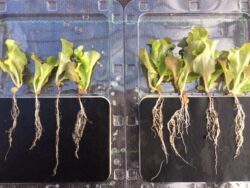Transplant stress is a source of uneven establishment leading to variable size and quality and yield at harvest. Here we discuss how stress and nitrogen influence hormone production and make the problem worse, and what we can learn from it to produce better crops.
Transplant stress is caused primarily by root damage, and cessation of root growth. Roots get disturbed and physically damaged during the process and struggle to supply adequate food and water to the top upon transplanting – hence the need for transplant water.
What is less well understood is the impact this root damage has on growth hormone production and stress hormone production.
The two major growth hormones produced in young plants are auxins (made in the shoots and transported down) and cytokinins (made in the roots and transported up). The process of transplanting damaged roots and reduces plant production of cytokinins but does not damage the shoot where auxins are produced. This tips the balance of hormones in the plant towards auxins being dominant.
When auxins become dominant over cytokinins, plants start to grow primarily at the top. When cytokinins are low, plants become more sensitive to ethylene a hormone that plants produce during stress periods that can weaken cells and leave plants more susceptible to fungal infections and wilting.
Once transplants are in the ground growers turn their attention to feeding them, this is where we have an opportunity to reduce stress or to make it worse depending on what form of nitrogen the transplant receives. To understand this we need to learn a little about how the different forms of nitrogen are processed by plants, and the effect they have on where plants grow.
Nitrate nitrogen is processed in leaves. When plants take up nitrates they are transported to leaves where they are changed into amino acids using a series of nitrate reductase enzymes. This process takes time and energy.
As nitrates accumulate in leaves awaiting processing plants synthesize more auxins, making seedlings become progressively leggy with growth at the top coming before root growth. This leaves the plant less able to establish, and more susceptible to ethylene.
Amine nitrogen is processed in roots and needs less energy to convert into amino acids. As amine nitrogen is processed roots grow and cytokinin production in the plant increases, leaving the plant better able to support growth at the top and less susceptible to ethylene.
Following transplanting supplying amine nitrogen is a good way to encourage root development and quick establishment. However, when conventional amine sources such as urea are applied, they are rapidly converted into nitrates by microorganisms meaning the plant receives mainly nitrate.
OMEX® brings LimiN, a chemistry that keeps nitrogen in the amine form to the marketplace. LimiN is used to make stabilized amine products known as Cell Power® SizeN® in the US. These products are very effective at establishing transplants. Here we showcase some research presented at the 2019 NFJ Horticulture Conference.
The picture below shows a lettuce germinated with conventional amine N (left) and with Cell Power® SizeN® stabilized amine nitrogen (right). There are clear and obvious differences in root architecture from very early growth in the plant development.

In research trials this effect was observed in transplanted seedlings treated with 2 Qts/Acre at transplanting and 2 Qts per Acre 12 days post transplanting. The graphs below show how root length and branching was significantly increased with LimiN stabilized Amine N (SizeN) than with identical quantities of conventional amine N.

When roots are properly established, they support better growth above ground. Feeding the shoots first at transplanting is ‘putting the cart before the horse’ reducing shoot growth in the long term.
The graph below shows the effect on head growth of conventional nitrogen sources and SizeN® (Stabilized amine) applied at transplanting 7 days after application. SizeN® significantly improved head development and yield when compared to all conventional nitrogen sources.

It is clear that getting transplants growing roots first leads to better yield. When shoot growth happens first it eventually falls behind as the roots fail to supply enough water and nutrients for sustained growth. Use of SizeN® to supply stabilized amine at transplanting helps the plant grow first roots and then the top giving better establishment uniformity and yield.
The product names and brands referenced here are registered and trademarks of OMEX® Agrifluids, Inc. © OMEX® Agrifluids, Inc. 2020.

